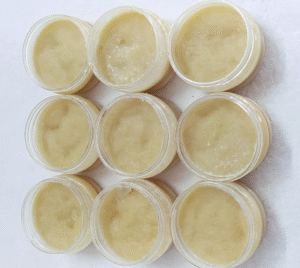Mango Butter - A Sustainable, High-Performance Emollient
Introduction
Mango butter, extracted from the kernels of Mangifera indica fruits. This rich, nutrient-dense butter offers a sustainable alternative to conventional emollients like shea or cocoa butter due to its unique fatty acid profile and skin-friendly properties. It is ideal for moisturizing, nourishing, and protecting formulations and aligns with the growing demand for ethically sourced, multifunctional ingredients.
Composition
High concentrations of stearic acid (35–45%) and oleic acid (35–50%), with smaller amounts of linoleic and palmitic acids along with naturally present antioxidants such as vitamin E, phytosterols and polyphenols. This composition provides exceptional oxidative stability, extending product shelf life without synthetic preservatives.
Melting Point: 32–42°C
Functional Properties:
A. Deep Moisturization: Forms a breathable, non-occlusive barrier to lock in moisture, ideal for dry or cracked skin.
B. Skin Barrier Repair: Phytosterols and fatty acids reinforce the lipid matrix, aiding in recovery from environmental stressors.
C. Antioxidant Protection: Neutralizes free radicals and reduces signs of aging, enhancing anti-aging formulations.
D. Lightweight Texture: Absorbs quickly without greasy residue, outperforming heavier butters like shea in fast-absorbing lotions.
E. Anti-Inflammatory: Soothes irritated or sensitive skin, making it suitable for post-treatment or eczema-prone formulations.
Applications in Cosmetics
- Skincare:
- Rich creams, body butters, and overnight masks for intense hydration.
- After-sun products or post-procedure balms to calm inflammation.
- Haircare:
- Leave-in conditioners or scalp treatments to combat frizz and improve manageability.
- Heat-protective serums leveraging its thermal stability.
- Lip Care:
- Balms and glosses for a silky, non-sticky finish
- Soaps:
- Adds hardness and creaminess to cold-process bars.
- Replacement of synthetic emollients or petrochemical derivatives in “free-from” formulations.
Sustainability
- Circular Economy: Ethically sourced mango kernels, typically discarded as agricultural waste, reducing environmental footprint.
- Biodegradability: Fully breaks down without ecological harm, unlike silicones or mineral oils.
Safety
Non-comedogenic (low clogging risk) and hypoallergenic. Suitable for sensitive or acne-prone skin.
Market Differentiation
Versus Shea Butter: Lighter texture and faster absorption address consumer complaints about greasiness.
Higher stearic acid content improves emulsion stability in formulations.
Versus Cocoa Butter: Less likely to solidify at room temperature, easing manufacturing processes.
Neutral odor avoids masking delicate fragrance profiles.
Combines emollience with active repair properties, reducing the need for additional actives.

Product Overview
Sourced from the kernels of Mangifera indica (mango fruit).
Key Attributes:
- Non-comedogenic, hypoallergenic, and suitable for sensitive skin.
- COSMOS-approved, vegan, and cruelty-free.
Technical Specifications
- Primary Fatty Acids:
- Stearic Acid (35–45%)
- Oleic Acid (35–50%)
- Melting Point: 32–42°C (ideal for skin-contact applications).
- Form: Semi-solid at room temperature; refined (odorless) or unrefined (natural aroma) variants available.
- Shelf Life: 18–24 months (naturally stabilized by vitamin E and phytosterols).
Functional Benefits for Formulators
- Superior Moisturization:
- Rapid absorption with a non-greasy finish, ideal for lightweight lotions and serums.
- Enhances skin barrier function via lipid replenishment.
- Oxidative Stability:
- Resists rancidity without synthetic antioxidants, reducing preservative reliance.
- Texture Versatility:
- Functions as a structurant in balms, sticks, and solid creams.
- Compatible with silicones, oils, and natural waxes.
- Anti-Aging Support:
- Neutralizes free radicals and reduces transepidermal water loss (TEWL).
Applications in Cosmetic Products
|
Category |
Use Cases |
|
Skincare |
Barrier creams, after-sun recovery balms, anti-aging serums. |
|
Haircare |
Heat-protectant stylers, leave-in conditioners, scalp treatments. |
|
Color Cosmetics |
Long-wear lipsticks, cream blushes, nourishing foundations. |
|
Clean Beauty |
Petroleum-free ointments, silicone alternatives in vegan lines. |
Market Differentiation
- Vs. Shea Butter:
- Lighter texture, faster absorption, and higher stearic acid content for improved emulsion stability.
- Vs. Cocoa Butter:
- Less brittle at room temperature; neutral odor avoids formulation interference.
- Sustainability Edge:
- Upcycled sourcing reduces waste; biodegradable profile meets eco-label standards (e.g., ECOCERT).
